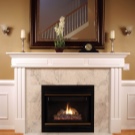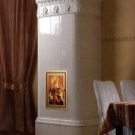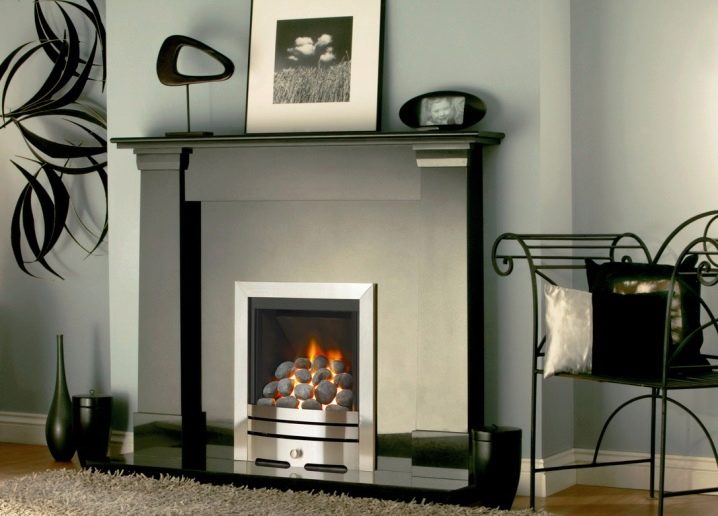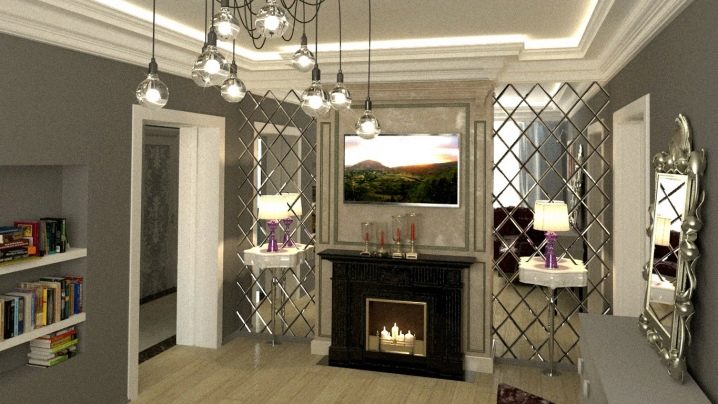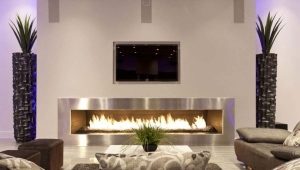Fireplace tiles
It may seem that when a fireplace is tiled, its heat capacity will decrease. But just the opposite, with the facing tiles near the fireplace, the heat transfer becomes higher and the room where the fireplace is located will warm up faster. But it is not enough just to buy tiles, it is necessary during adhering works to adhere to certain rules.
Features of use for cladding
The peculiarity of any tile for facing the fireplace is that it must have a high temperature resistance. Choosing a specific type of tile, you need to pay attention to its compliance with the parameters:
- the possibility of operating this tile at high temperatures must be indicated;
- the tile must be sufficiently strong, at least 8 mm thick. If the tile is thinner, it will simply crack at the first heating of the fireplace;
- tile structure should be low porous.
Not all facing tiles meet all these requirements,so the choice will not be too extensive:
- terracotta tiles;
- majolica;
- tiles;
- ceramic granite;
- clinker (intended only for fireplaces and stoves).
Species
All of the listed tiles for the fireplace, as well as other options, have a different structure, are made differently and have a different cost.
- Majolica is a pressed tile with a decorative pattern on the glaze surface.
- Terracotta is about the same, but neither the glaze nor the decorative pattern such tiles do not have. The cost of such tiles apiece - from 100 to 1000 rubles.
- The clinker is the same ceramic tile, but more complex in structure and slightly thicker. Such facing will be more expensive than the two previous options.
- Tiles are a ceramic tile with a pattern applied on it. It's expensive.
- Porcelain is a modern veneer, the operational properties of which most resemble natural stone.
Heat resistant
At the heart of heat-resistant tiles - special clay, which consists of special minerals (aluminosilicates). Chemical components of this mineral, such as sodium, kaolin, magnesium and other metal oxides, determine the color options of the product.
The tile is produced with a different design, so it is possible to choose it with a simple pattern, for example, for a bathhouse, and one that will harmoniously fit into the style of a particular room.
Marble
But there are many other materials that can decorate indoor fireplaces. Here, for example, marble has already learned to decorate not only the facades of buildings. It is now an important element in many interiors. A vivid example of this is to finish an indoor fireplace with the help of marble slabs, and this is truly a real trend of our time.
Options for marble decor
The shape of decorative elements in marble can be different, except for the usual tiles, this material is used in columns, in statues, in overlaid corners. And there are options for the use of fully finished marble portals, ready for installation and fixation.
Clinker
Clinker tiles for the fireplace can be used instead of facing bricks. Outwardly, these two materials are very similar, but there are still significant differences between them. First of all, the clinker tile is much thinner than the facing brick, and they differ in the whole set of technical characteristics.Correctly selected tiles are a guarantee that the fireplace will work with increased efficiency, which directly depends on the thermal conductivity and heat capacity of the selected lining.
Terracotta
Terracotta tiles are widely used as a cladding material. And this is not only a fireplace or stove, the facades of buildings and fences look great with this decor. Terracotta tiles have excellent technical properties and are visually attractive, therefore they are ideal as facing, for example, barbecue, barbecue or bath.
Terracotta tiles are natural white kaolin clay without any additives. The tile turns out after long (more than 48 hours) roasting at a high temperature (more than 1100C).
Tile
Of all the options for facing fireplaces, the use of tiles is considered the best. This is a champion among all ceramics for the quality of finishing, and a material that meets all the necessary parameters in this case. But certain rules and skills for styling such cladding, of course, exist, and they should be followed.
This process is quite complicated and time consuming, but the result will be amazing.The price of facing from tiles is rather big, and therefore it makes sense to do everything yourself, then the whole construction will take significantly less money. In this case, there is one nuance - it is still recommended to do the laying in four hands, because the work on laying bricks and tiles should be carried out in parallel.
Tiled
There are many types of tiles, but not all of them are suitable for a fireplace. We need such options when the tile will not fall into disrepair from the constant process of heating / cooling.
Ordinary clay and cement mortars are not suitable for ceramic facing of the fireplace, here you will need special adhesive mixtures.
Majolica
Majolica refers to the old glazed tiles with which the furnaces were veneered. The tile is obliged by the name to the Spanish island under the name Mayorsky. There it was invented. It was a place from which merchants have long engaged in the transportation of tiles, dishes and other products painted with tin-lead glaze. In Europe and Russia, rumors about the existence of such ceramics came much later.
The basis of such techniques as majolica, is the manual labor of talented artists who are engaged in painting.For this reason, in ancient times, only the most wealthy people could afford to lining fireplaces with the help of majolica, and even nowadays this pleasure is not cheap.
Gypsum
Decorating a stove or fireplace with a mixture of gypsum is a rather original solution, and it is beneficial for many positive reasons:
- the possibility of creating a unique design;
- this is a low-cost lining method;
- everything can be done personally;
- the design will turn out bright and unique, because it will depend only on your imagination;
- will have to work with available materials that do not represent any difficulty in their use;
- this finish is environmentally friendly, because it has no harmful substances;
- the fireplace with plaster trim will be provided with durability, thanks to the resistance of all elements to high temperature and many other negative influences.
Plaster mix for facing of a fireplace by means of a plaster mix - the excellent choice, it is an opportunity to design any jewelry which your imagination can create.
Granite
Granite tiles are called a mixture of quartz sand, clay of different varieties and chips (from marble and granite).Metal salts and oxides are used as dyes, and environmentally friendly substances are used as a coating.
The structure of the granite tile is quite dense and non-porous, can withstand both high temperatures and low.
It is possible to make an imitation of all the above options for the coating, as well as natural stone, from granite tiles. The color of the granite tile does not change even from direct sunlight.
The thickness of the granite tiles are from 9 to 12 mm and are attached with hot melt. In order to use the fireplace with granite tiles facing outdoors, instead of hot melt it is better to use frost-resistant glue.
Chamotte
Chamotte tile is also called acid-resistant, and it is suitable as a cladding, both for the stove and for the fireplace. The tile perfectly transfers both heat and cold. This is an excellent finishing finish, the tile can be different in size and according to the conditions of its operation.
In the production process, the chamotte tile is subjected to the endurance test with a hot surface and frost, which can be used in everyday life and at work.
The tile consists of refractory grades of clay with the addition of stone flour.Firing involves 1300C, the finished tile turns porous, has increased strength, is resistant to the effects of acid, fire, alkali, solvent and other substances.
Design
Room fireplace not only heats the room, it is also a chic decoration. Its shape and decoration largely affect the overall style of the room, so the design of the indoor fireplace is an important matter.
It is possible to make a fireplace more attractive in different ways, depending on the finishing materials (natural and artificial) used for this purpose.
The most common way to place a fireplace is to use tiles. The material should conduct heat well.
This method of fireplace design has many advantages:
- material is available in different shades and in its texture;
- high temperatures are not terrible;
- there are no problems with tile care;
- there are various other options, except for one selected composition;
- tile easy to lay.
It should be borne in mind that for facing the fireplace it is better to select tiles of small sizes, so the probability that it will crack will be much lower.
Under gzhel
In Russia, the fact that the stove can be decorated and at the same time decorated with tiles, we learned in the XVI century. The efficiency of the furnace and safety equipment increased, and the whole room in which it was located took on a completely different look.
Masters learned to decorate stoves and fireplaces with original ornaments, and for a long time tiles (with a relief and flat) were considered fashionable among Russians.
At first, Gzheli could only afford to decorate a stove or a fireplace, but very quickly this lining began to be considered a Russian tradition.
Under the stone
The fireplace is, as a rule, a place in the house, beloved by all, and it is he who has the family gather in his spare time to socialize. It will be doubly pleasant to sit by the fireplace with a beautiful finish, and just such is the finish of the tile under the stone. Decorative stones turn out strong, reliable, durable and beautiful.
Modern technologies allow to make tiles from decorative stone of any kind, and they will be as similar to the natural analogue as possible. What is tile under stone made of:
- from sand;
- cement;
- fillers (expanded clay sand and perlite);
- gypsum;
- natural pigments.
Manufacturing technology is quite simple: you just need to pour the prepared mixture into a special form with reliefs and wait until it settles.
It is important that cement-based tiles are moisture resistant, which is not the case for pure gypsum finishing.
Under the brick
Finishing of facing provides pre-laying of refractory bricks. This material is a bright color and smooth to the touch, besides it will be very good to keep the heat in the room.
In the construction of the fireplace there are some discrepancies with the construction of the furnace, but insignificant. The stove, like the fireplace, is built of refractory bricks (it is also called a special stove), and for decoration, a facing tile for brick will be an excellent choice. Such a fireplace will turn out not only a useful thing in the house, but also very beautiful. But you can do as a decoration and just plastering and subsequent whitewashing.
Mirror
Mirror tile looks very unusual as a fireplace decoration. This finish is perfect for a modern interior in high-tech style, as well as minimalism. For its installation, it is necessary to use heat-resistant reinforced glue, specially designed for facing a surface that will be exposed to high temperatures.The heat resistance of such glue is 400C, and it is necessary to apply it both on the chimney surface and on the tile itself.
In addition, mirror tiles are used to decorate a false fireplace. The mirror surface of its back wall will reflect the flame of the candles placed on the imitation portal of the false fireplace, thereby creating the effect of natural fireplace light. And if you put a mirror tile and portal false fireplace, the reflection will be graphic.
Mural
This method of tiling a fireplace will turn it into a work of real art. It can be an image under a tree or stone, or beautiful plants, fruits, original patterns, or just a textile motif, when the surface of the fireplace can not be distinguished from canvas or fabric of a different texture.
Any fireplace tile is a durable material that is moisture resistant, will last more than a dozen years. In addition, the material from which the panel will be made is fire-resistant and environmentally friendly, which means that this lining is not subject to fire and, when heated, will not emit harmful substances.
Care of the panel is quite simple - with the help of ordinary detergent.
KP sizes
The thickness of the fireplace tile is usually within 8 mm, for clinker and granite, this millimeter value is 2 less due to the strength of these materials.
Regarding the size of the tile itself, experts do not recommend using gearboxes larger than 25 * 25 cm. This is due to the inconvenience of working with large sizes: the tile will have to be cut frequently, and there is no certainty that such tile will be a good burden for heat-resistant glue.
But it is also inconvenient to work with very small tiles, and therefore a size of less than 10 * 10 cm is also not suitable.
How to make your own DIY
To make a fireplace lining in a country cottage, in the country or in a private house with your own hands - this means, then for many years to enjoy the fruits of their work and ensure a comfortable rest for themselves and all households. This will require some preparation.
As the professionals put it, making a fireplace lining means applying a finishing finish to the structure itself. Tiling a fireplace is the most common method. The master stove-maker will do an excellent job with this work, but the technologies are not so difficult here to not cope on their own.





























